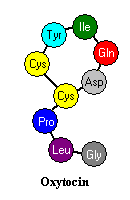VIVO Pathophysiology
Oxytocin

Oxytocin in a nine amino acid peptide that is synthesized in hypothalamic neurons and transported down axons of the posterior pituitary for secretion into blood. Oxytocin is also secreted within the brain and from a few other tissues, including the ovaries and testes. Oxytocin differs from antidiuretic hormone in two of the nine amino acids. Both hormones are packaged into granules and secreted along with carrier proteins called neurophysins.
Physiologic Effects of Oxytocin
In years past, oxytocin had the reputation of being an "uncomplicated" hormone, with only a few well-defined activities related to birth and lactation. As has been the case with so many hormones, further research has demonstrated many subtle but profound influences of this little peptide, particularly in regards to its effects in the brain. Oxytocin has been implicated in setting a number of social behaviors in species ranging from mice to humans. For example, secretion or administration of oxytocin in humans appears to enhance trust and cooperation within socially-close groups, while promoting defensive aggression toward unrelated, competing groups.
Oxytocin has been best studied in females where it clearly mediates three major effects:
- Stimulation of milk ejection (milk letdown): Milk is initially secreted into small sacs within the mammary gland called alveoli, from which it must be ejected for consumption or harvesting. Mammary alveoli are surrounded by smooth muscle (myoepithelial) cells which are a prominant target cell for oxytocin. Oxytocin stimulates contraction of myoepithelial cells, causing milk to be ejected into the ducts and cisterns.
- Stimulation of uterine smooth muscle contraction at birth: At the end of gestation, the uterus must contract vigorously and for a prolonged period of time in order to deliver the fetus. During the later stages of gestation, there is an increase in abundance of oxytocin receptors on uterine smooth muscle cells, which is associated with increased "irritability" of the uterus (and sometimes the mother as well). Oxytocin is released during labor when the fetus stimulates the cervix and vagina, and it enhances contraction of uterine smooth muscle to facilitate parturition or birth.
In cases where uterine contractions are not sufficient to complete delivery, physicians and veterinarians sometimes administer oxytocin ("pitocin") to further stimulate uterine contractions - great care must be exercised in such situations to assure that the fetus can indeed be delivered and to avoid rupture of the uterus. - Establishment of maternal behavior: Successful reproduction in mammals demands that mothers become attached to and nourish their offspring immediately after birth. It is also important that non-lactating females do not manifest such nurturing behavior. The same events that affect the uterus and mammary gland at the time of birth also affect the brain. During parturition, there is an increase in concentration of oxytocin in cerebrospinal fluid, and oxytocin acting within the brain plays a major role in establishing maternal behavior.
Evidence for this role of oxytocin come from two types of experiments. First, infusion of oxytocin into the ventricles of the brain of virgin rats or non-pregnant sheep rapidly induces maternal behavior. Second, administration into the brain of antibodies that neutralize oxytocin or of oxytocin antagonists will prevent mother rats from accepting their pups. Other studies support the contention that this behavioral effect of oxytocin is broadly applicable among mammals.

While all of the effects described above certainly occur in response to oxytocin, doubt has recently been cast on its necessity in parturition and maternal behavior. Mice that are unable to secrete oxytocin due to targeted disruptions of the oxytocin gene will mate, deliver their pups without apparent difficulty and display normal maternal behavior. However, they do show deficits in milk ejection and have subtle derangements in social behavior. It may be best to view oxytocin as a major facilitator of parturition and maternal behavior rather than a necessary component of these processes.
Both sexes secrete oxytocin - what about its role in males? Males synthesize oxytocin in the same regions of the hypothalamus as in females, and also within the testes and perhaps other reproductive tissues. Pulses of oxytocin can be detected during ejaculation. Current evidence suggests that oxytocin is involved in facilitating sperm transport within the male reproductive system and perhaps also in the female, due to its presence in seminal fluid. It may also have effects on some aspects of male sexual behavior.
Control of Oxytocin Secretion
The most important stimulus for release of hypothalamic oxytocin is initiated by physical stimulation of the nipples or teats. The act of nursing or suckling is relayed within a few milliseconds to the brain via a spinal reflex arc. These signals impinge on oxytocin-secreting neurons, leading to release of oxytocin.
If you want to obtain anything other than trivial amounts of milk from animals like dairy cattle, you have to stimulate oxytocin release because something like 80% of the milk is available only after ejection, and milk ejection requires oxytocin. Watch someone milk a cow, even with a machine, and what you'll see is that prior to milking, the teats and lower udder are washed gently - this tactile stimulation leads to oxytocin release and milk ejection.
A number of factors can inhibit oxytocin release, among them acute stress. For example, oxytocin neurons are repressed by catecholamines, which are released from the adrenal gland in response to many types of stress, including fright. As a practical endocrine tip - don't wear a gorilla costume into a milking parlor full of cows or set off firecrackers around a mother nursing her baby.
Both the production of oxytocin and response to oxytocin are modulated by circulating levels of sex steroids. The burst of oxytocin released at birth seems to be triggered in part by cervical and vaginal stimulation by the fetus, but also because of abruptly declining concentrations of progesterone. Another well-studied effect of steroid hormones is the marked increase in synthesis of uterine (myometrial) oxytocin receptors late in gestation, resulting from increasing concentrations of circulating estrogen.
Updated 2018. Send comments to Richard.Bowen@colostate.edu
A Bosnian translation of this page by Amina Dugalic is available at Bosnian translation
A Estonian translation of this page by Karolin Lohmus is available at Estonian translation
A Finnish translation of this page by Elsa Jansson is available at Finnish translation
A French translation of this page by Mathilde Guibert is available at French translation
A Hungarian translation of this page by Elana Pavlet is available at Hungarian translation
A Spanish translation of this page by Anibal Goransky is available at Spanish translation
A Ukrainian translation of this page by Olena Chervona is available at Ukrainian translation

